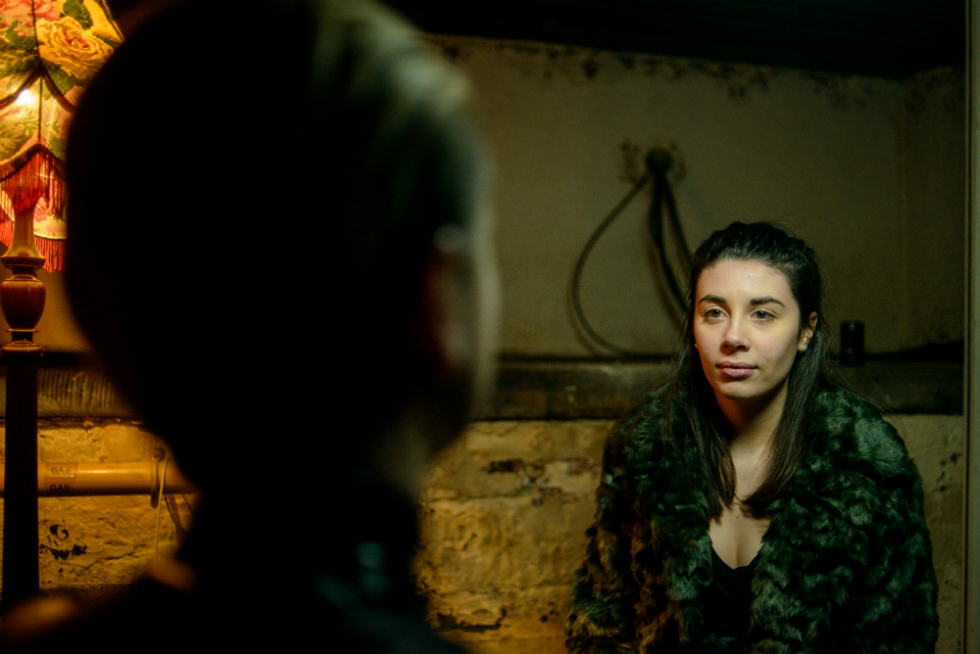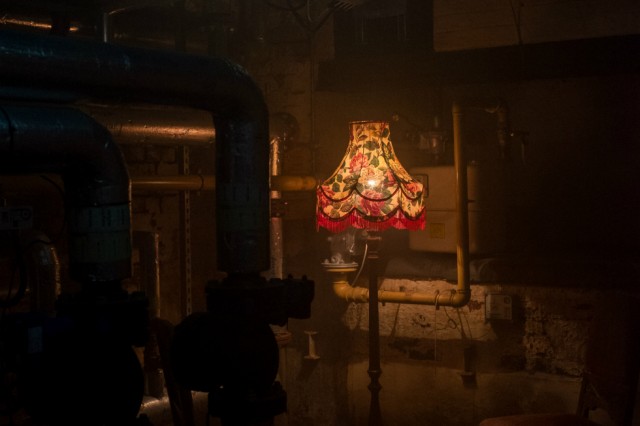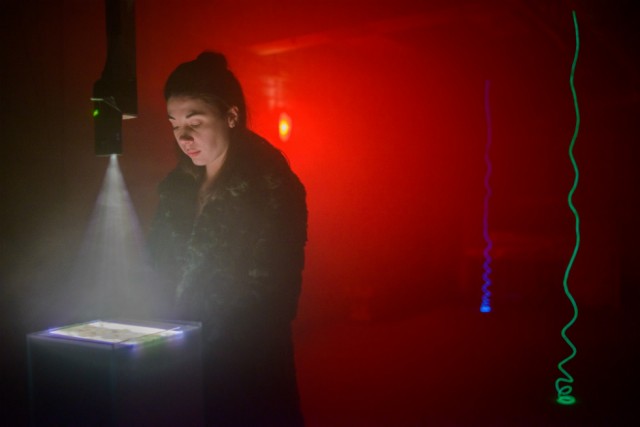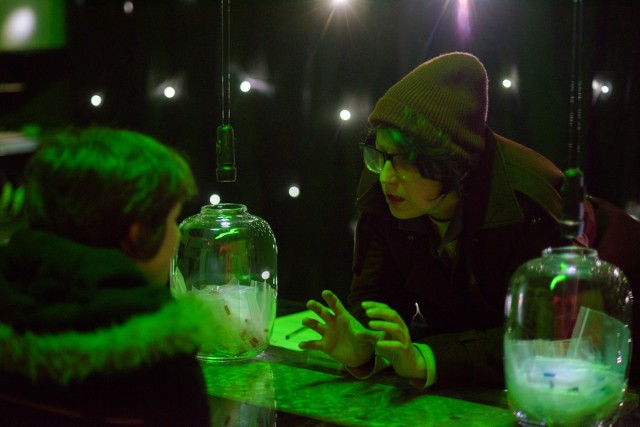“Forcing me into self-interrogation”: Veracity/Liverpool Provocations — Reviewed

Lesley Taker is led to a secret location to encounter live surveillance, George Orwell and an exploration of our mediated existence…
A Friday afternoon, straight from the office with a very busy brain, seems to be fitting mental setting to experience a new work by artist Julieann O’Malley, which promises to ‘intervene’ into my everyday. This commission by Metal Culture and 67projects is part of a series of January Liverpool Provocations around the city which stem from the viewpoint that: “It is easier to imagine the end of the world than an alternative to capitalism”; something which features large in Veracity, a dystopian, multimedia installation experience for one.
The first hint of the ‘disruptive’ nature of O’Malley’s work was the moment I bought a ticket; instead of receiving a final destination, I was given a liaison point where I would meet an unnamed guide who would lead me to a secret location. I am a bit of a sucker for anything which rings of espionage, and I’m very interested in this idea of making people a little unsettled before bringing them into a performance, so I like the setting of a decommissioned bus stand as a pick-up point. I am oddly nervous and arrive early, flicking through emails on my phone as I consider what lies ahead.
Standing in Stand 12, Queen’s Square Bus Station, part of me even thinks for one second that Julieann O’ Malley’s voice is reciting the announcement of bus schedule changes, but I realise that — having heard her voice before — the Yorkshire twang isn’t quite right. Someone in a high vis jacket walks past me, looks in the bin to my left and picks out some rubbish. I look up from my emails and wonder whether I am about to be collected. It turns out my overactive imagination has made this council employee complicit in the action, but he has no idea of the other, subversive use of this property.
Eventually, I am collected by a silent woman with a whiteboard — I know before she tells me that I shouldn’t speak to her — we communicate in nods and half smiles and start to walk away from the busy Queen’s Square location. She crosses roads with me and leads me into a red-brick building, pointing me towards the basement and nodding her goodbye. As I descend, past pipes and control boxes, I come to a desk behind which is seated a boiler-suit clad female, boasting a co-operative badge naming her ‘Steve’. She asks me questions about my dreams: do I dream? Are my dreams vivid? Do they feel real or just as if they could be real? How do I know when I am dreaming and when I am awake?
Between the neon green lighting, the utilitarian setting, and the two glass vases either side of me containing blue and red pills respectively, I am reminded very strongly of The Matrix (1999). This is not at all what I expected. I, of course, take the red pill and agree to continue my descent into the building; and one can assume, my subconscious. I even sign a form to this direction, handing myself over to the artist for the duration. Leaving most of the boxes about medical conditions unchecked, I do tick the box which asks if I am ‘Sympathetic’. Steve approves and we move on. Steve tells me to be careful… but not too careful. And then assures me there is such a thing as too careful.

Led by Steve into a projection space which is filling with haze and a very bass-heavy soundtrack, I am told to sit on my hands and watch the screen. For a very long time I am unable to fully focus on the film because I am very interested as to why I am sitting upon my hands. I begin to think about ideas of helplessness, experimentation, being reprimanded, and — given the backdrop — a small part of me is thankful that I know O’Malley doesn’t tend towards shock tactics.
When I do manage to get out of my head a little bit, I settle into the rhythm of lapping waves. The video in front of me has been filmed on a beach: the waves creeping further towards me on each return, and then, a snap — a momentary blip — and the waves seem to reverse. I cannot remember if they were coming closer, or moving away. I enjoy this unsettled narrative and feel I could stay here a lot longer. It is as if I am in an antechamber attempting to subject my busy, bustling brain to some form of decompression. It is working, but comes to an end quickly as I am taken into another room. Steve wants to show me something…
I barely take in the rest of the dark room, except for some glowing UV strands which give the basement a light rave vibe, as I am instructed to watch a film projected onto a white opaque monolith. The video, at first indistinct, becomes clearer as it flashes between clips from Channel Five’s Big Brother; including people talking or playing to camera, and living their lives out on screen. I remember reading Veracity’s press text, which includes a nod to George Orwell and the focus on identity in an age of mass surveillance. I begin to, obviously, sense the unfolding of a narrative not dissimilar to the one which flows through Follow, FACT’s current exhibition: the relationship between consumption, consumerism and capitalism and the affect this has upon our identities. This focus on celebrity as a commodity, a currency, and an indication of a seismic social shift towards a blurring of private and public. The title, Veracity, ties into this; as does the whole performance. Everything is constructed to encourage you to question the ‘real’ world, and make you pause to examine your own authenticity within an existence so often plagued by misconstruction, error and bad copies.
In my peripheral vision, I notice a hovering drone, and begin to hear a familiar tinny buzz. I keep watching the screen, partially not wanting to miss anything, partially because I am pretty unsure how to act around a drone. As my eyes adjust to the darkness a little more, I see it isn’t a drone, but someone clad in black, carrying two speakers, glowing with LEDs.

This is O‘Malley, slowly pacing towards me dressed in a skin-tight black catsuit which looks like it has been clawed at. Her slicked black hair and Black Swan-style make up adds to the cyberpunk, dystopian aesthetic and she stares at me levelly as she approaches. She places the speakers either side of my head, immersing me in the hissing static for a moment, and then creating a Doppler effect between us as she transfers the speakers from my ears to hers in a sweeping motion, again and again, gathering speed with each exchange. O’Malley unifies us in this way, meeting (rather, demanding) my gaze straight on throughout, and then slowly places a speaker centrally on each of our chests. These tiny pieces of technology feel almost like a prosthetic, more part of her gesture than part of her outfit. Our unification is complete; her robotic connection to me is achieved and she is ready to take me into another space. She asks a familiar question: “Will you follow me?” I do.
We sit in the very bowels of the building; a dusty basement complete with improbably plush props, an operatic soundtrack, and this synth version of O’Malley drawing my attention to a surveillance monitor to my left: “They are always watching. They hear everything.” She then asks me questions about the world – about my world — and about my place within it. My wants, my desires, my fears, my hopes. The impossibility of imagining a world without consumerism. The nature of love. Her detached yet interested queries and statements develop a relationship of observer and observed within a context of mass surveillance.
Are her people the ones who are watching, or mine, or another, third, interested party? Or is she some element of my subconscious, forcing me into self-interrogation? The idea of this world being my world never sits quite comfortably; it seems a little prescriptive, but then given the constant mass media coverage of this version of the world, one cannot blame the algorithms for being a bit blunt. For supposing everyone is the same. I answer the questions with curiosity, knowing my own questions wouldn’t be answered, but looking for my partner’s response within any movement, slight inflection. The way one would examine someone slightly unreal, something they were not entirely sure was human.
I realize I am subjecting the artist to this gaze as much as she is doing the same to me. This quantitative examination goes both ways. When we survey, we do so through our own idiosyncrasies, knowledge and bias; we hold up a mirror, rather than a looking glass. This (along with my all too brief time faced with the waves) is the most affective part of the whole performance for me. In many ways, I am somewhat let down by the excessive staging, some of the clunky replication of the tropes of science fiction and the (I believe fully intentionally) hammy artifice, but this focus on the intensity and reflexivity of surveillance — and the weight of sympathy which sits behind the artist’s eyes throughout our interaction — are where the power lies.

We sit, looking at one another as O’Malley questions me, and all I really connect to is the empathy she is exuding. I recall ticking the box ‘Sympathetic’ and wonder if this approach is designed for me, for my ‘type’ of person.
Finally, this approximation of a replicant asks if I am ready to go back into my world and to make a difference. I reply that I am, as is expected, and am turned out into the world. I leave feeling a little let down by my experience, a little deflated at the overt artifice of many of its aspects. I recall the artist’s earlier work which had affected me so viscerally, which I felt rigorously explored the themes it was designed to tackle in both subtle and blunt ways. Veracity may have been a bit too rushed, a bit too heavy on the semiotics, a bit much, yet somehow not enough.
Later, walking through a crowded shopping centre filled with people rushing in and out of red-postered shops, grabbing anything they can at reduced costs, surrounded by a different kind of artifice, I am reminded of Hito Steyerl’s essay Too Much World (2013). I remember thinking about similar concepts not so long ago and how one could design an environment that was at once constantly too much, but never really enough; a fitting stage for an exploration of our mediated existence. Suddenly, O’Malley’s robotic avatar comes into my mind: this individual removed from society but still so much a part of it; an inescapable product. I think of the stuttering sea, of spending a moment underground, of excess, of unavoidable theatrics, of the ever-changing game of identity, the vibration of a tiny speaker upon my breastbone and of those very human, very loving, and very, very worried eyes.
Lesley Taker
Lesley went to see Veracity by Julieann O’Malley as part of Liverpool Provocations, a series of four new public realm art works based in and around the city centre throughout 18-23 January 2016, including:
FOUR WORDS by artist Alan Dunn, on The Media Wall opposite Lime Street: a stream of provocative 10-second animations of four word statements, including contributions from Gerhard Richter, Douglas Coupland, Levitt & Dubner (‘Freakonomics’), David Shrigley and more;
SHRINE by music producer and artist Forest Swords, at the Black-E: a physical and aural exploration of the body and breath;
BIG MOUTH by MEYOUANDUS, at various locations including Church Street: a mobile, 360° projection that invited participants to speak their deepest thoughts in confidence.
Images: Veracity by Julieann O’Malley as part of Liverpool Provocations; all courtesy credit Mark McNulty





